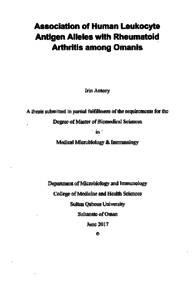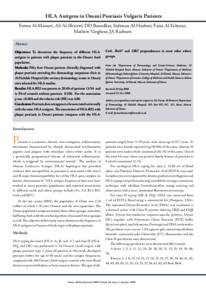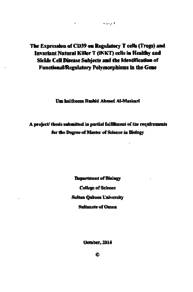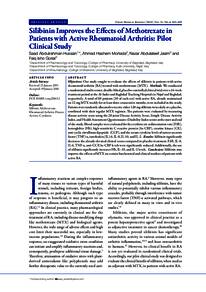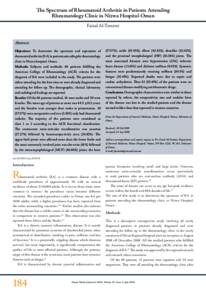Document
Association of human leukocyte antigen alleles with rheumatoid arthritis among Omanis
Publisher
Sultan Qaboos University
Gregorian
2017
Language
English
Subject
English abstract
Background: Rheumatoid arthritis (RA) is a chronic, progressive, inflammatory autoimmune disease that mainly targets the synovial membrane of the diarthroidal joints. The global prevalence of RA is estimated to be 0.24% and the prevalence rate is more in the female population (3:1) and increases with age. The major genetic risk factor for RA is conveyed by the human leukocyte antigen (HLA) genes. The HLA genes are highly polymorphic and differ between different populations, which influences the disease.
Aims: To investigate whether an association exist between HLA alleles and RA among Omanis by determining, the frequency of HLA class I and II alleles among Omani RA patients and control groups, and the HLA allele(s) that is/are associated with RA and its parameters among the Omani population. Methods: - We included 102 RA patients fulfilling the 2010 American College of Rheumatology/European League Against Rheumatism (ACR/EULAR) classification criteria and 104 individuals who are not affected by RA and/or any other autoimmune disease as controls. A total of 5 ml blood was collected from each individual. DNA was extracted and the HLA typing was performed using the Polymerase Chain Reaction Sequence Specific Primers (PCR-SSP) methodology. The Chi square test was used to investigate the significance of the associations. A p value <0.05 was considered significant.
Results: HLA-B*15 (p=0.007), C*02 (p=0.001), DRB1*01 (p=0.039), DRB1*04 (p=0.004) and DRB4 (p=0.022) were associated with the susceptibility to RA. HLA-B*18 (p=0.005) and B*58 (p=0.002) were associated with protection against RA. We also observed associations in RA patients between different HLA alleles and different RA related parameters. Red blood cell (RBC) and platelet counts were associated with HLA B*40 and HLA-B*07 respectively, hemoglobin levels with HLA-A*74 and HLA DRB1*11. We observed association between erythrocyte sedimentation rate (ESR) and HLA-B*41, C+08 as well as DRB1*01, C-reactive protein (CRP) and HLA-B*41, C*17 as well as DQB1*01. The neutrophil count was associated with HLA-DRB1*12 and DQB1*03, lymphocyte count with HLA-A*24, B*23, C*08 and DQB1*04, monocyte count with HLA-A*33, C*04 and DRB1*10, and eosinophil count with HLA-DQB1*04. In addition, HLA-A*03, A*32, B*58 and DRB1*12 were found to be associated with WBC count. The levels of alkaline phosphatase (ALP) were found to be associated with HLA A*32, B*58 and C*03, while phosphate levels were associated with HLA-C*03. HLA C*04 and DRB1*04 were found to be associated with total calcium (total) levels and HLA A*01, A*02, B*53, C*16, DRB1*13, DQB1*03 and DQB1*05 were associated with albumin levels.
Conclusion: We identified certain HLA Class I and I alleles that are associated with RA and its parameters among the Omani population. This confirms the involvement of both CD4+ and CD8+ T lymphocytes in the pathogenesis of RA and provide potential clues for a better management of RA in Omani patients.
Description
Thesis
Member of
Resource URL
Arabic abstract
العنوان: العلاقة بين جزيئات التوافق النسيجي (HLA) ومرض التهاب المفاصل الرثوي الروماتيزم) لدى العمانيين المقدمة: يعتبر مرض إلتهاب المفاصل الرثوي مرض مناعي مزمن يتطور بشكل تدريجي عند المرضى ويستهدف بشكل خاص الغشاء الزليلي المفاصل. تقدر نسبة انتشاره حول العالم ب % . 24 و نسبة إصابة النساء به أكبر من نسية إصابة الرجال بمعدل (1 : 3) وتتزايد فرص الإصابة مع التقدم في العمر. من أهم الأسباب المرتبطة بالإصابة بهذا المرض هو العامل الوراثي لجزينات التوافق النسيجي (HLA). هذه الجزيئات تختلف بشكل كبير بين البشر وتلعب دورا كبيرا في الإصابة بأمراض مختلفة أهداف الدراسة: تهدف هذه الدراسة إلى الكشف عن مدى انتشار جزيئات HLA لدى العمانيين الأصحاء بالمقارنة مع مرضى التهاب المفاصل الرثوي وذلك بتحديد النسبة المئوية للأفراد الحاملين لكل جزئ في هاتين المجموعتين. كما تهدف أيضا لمعرفة العلاقة بين جزيئات HLA والإصابة بهذا المرض و العوامل المرتبطة به طرق الدراسة: شارك بهذا البحث 104 عماني غير مصابين بأي مرض و102 مريضا عمانيا مصابة بالتهاب المفاصل الرثوي وصنفوا بحسب معايير تصنيف الكلية الأمريكية للروماتيزم 2010 او الاتحاد الأوروبي ضد الروماتيزم. تم أخذ قرابة 5 مللتر من الدم من جميع الأفراد المشاركين ومن ثم تم استخلاص الحمض الريبي النووي المنقوص الأوكسجين (DNA) منها، ثم تمت مضاعفة الى DNA عن طريق التفاعل التسلسلي (PCR). بعد ذلك تم معرفة جزيئات الHLA عن طريق استخدام برنامج Score، وكذلك تم حساب نسب تواجد الجزيئات في مجموعتي المشاركين، ودراسة امكانية وجود علاقة بين هذه الجزيئات والاصابة بمرض التهاب المفاصل الرئوي، او باي من العوامل المرافقة له النتائج: لوحظ وجود اختلاف بين العمانيين الأصحاء ومرضى التهاب المفاصل الرثوي في توزع بعض جزيئات التوافق النسيجي (HILA). حيث وجدنا أن 04* HILA - B * 15 , C + 02 ,DRB1 * 01 , DRB1 و DRB4 ترتبط بخطر الإصابة بالمرض. أيضا وجدنا أن 18* HLA - B و58*B ترتبط بالحماية من المرض لدى العمانيين. بالاضافة الى ذلك وجدنا أن هناك علاقة بين عدد من جزيئات الHLA و عوامل متعلقة بالمرض كعدد كريات الحم الحمراء (RBC و خلايا الدم البيضاء (MBC) خاصة الخلايا البيضاء العيلة و الخلايا البيضاء الحمضية و الخلايا اللمفاوية و الخلايا الوحيدة، و كذلك عند الصفائح الدموية، نسبة هيموجلوبين الدم، سرعة تثقل الدم (ESR)، نسبة البروتين الارتكاسي CRP ) C ) ، مستوى الفوسفات و الفوسفات القلوية (ALP)، مستوى الكالسيوم، ومستوى الزلال الخاتمة: في هذه الدراسة لوحظ وجود علاقة بين نوعي جزيئات التوافق النسيجي ومرض التهاب المفاصل وأعراضه لدى العمانيين، مما يشير الى أهمية خلايا الدم اللمفاوية ت المساعدة (CD4) و القاتلة (CD8) بتطور مرض التهاب المفاصل الرثوي. يمكن الاستعانة بهذه النتائج لعلاج هذا المرض بين العمانيين.
Category
Theses and Dissertations

